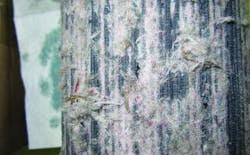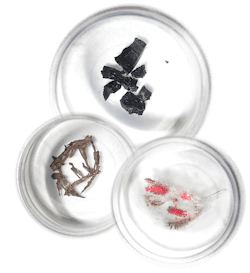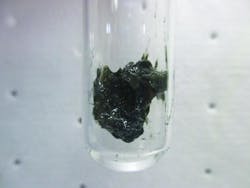Using a root cause analysis to solve plant mysteries and prevent unplanned downtime
It is everyone’s goal to avoid unplanned downtime. Unfortunately, the unexpected does happen, causing a flurry of activity to get equipment and processes back up and running. Ideally, this activity should include a root cause analysis (RCA) of what went wrong, so that maintenance procedures can be developed or adjusted to help prevent the issue from happening again.
The crime scene
Sometimes the root cause analysis investigation reveals the presence of a mysterious unidentified material or deposit that seems to be responsible for the shutdown. What is this stuff? Where did it come from? How can we keep it from coming back? Just like investigating a crime scene, forensic analysis of the evidence found can provide useful information. Forensic laboratory analysis of the material can help to identify the material, which can determine the material’s origins and help develop an action plan to prevent it from happening again. Let’s take a look at some examples of how forensic laboratory analysis was able to help.
Case file: Why is my filter wearing a pink sweater?
A bottom roll hydraulic system was exhibiting high differential pressure across the lube oil filter. When the filter was removed, it was observed to be covered in pink, fibrous material (see Figure 1). The filter looked as if it were wearing a fuzzy pink sweater! The filter was sent to the laboratory in order to characterize the material. Upon arrival at the lab, close inspection revealed the presence of three distinct foreign materials captured in the filter media: a black solid material, a brown solid material, and pink woven material (see Figure 2). The pink woven material was the most abundant material present and was the primary cause of the plugged filter.
Laboratory analysis of the black material characterized it as polypropylene. The brown material was characterized as Teflon. The pink material was characterized as polyethylene terephthalate. Identification of the materials present allowed the investigative team at the plant to track down and confirm the sources of the material.
The black polypropylene and brown Teflon were traced back to seals and gaskets in the lubricating system. The pink polyethylene terephthalate was traced back to a welding rag, which had accidentally been dropped into an open hatch by a contractor working at the plant. Knowledge of the root cause of the introduction of the pink material that plugged the filter allowed the plant to develop better training for outside contractors to have a better awareness of their surroundings and be responsible for their materials.
Case file: The clogged applicators
A plant process involved coating manufactured parts with a protective coating. The coating application process suddenly developed issues with clogging of the applicator blades, resulting in uneven, streaky coating of the parts. This was putting the delivery of the promised shipments in jeopardy and was a serious concern.
Samples of the coating material collected from the application system were sent to the lab, along with samples of the coating material from the bulk delivery. Upon arrival at the lab, a color variation was observed in the sample collected from the application system. The discolored portion was isolated and analyzed with FTIR spectroscopy and was determined to contain calcium carbonate (see Figure 3). The presence of calcium carbonate was unexpected, as it was not part of the formulation of the coating material. The new product sample of the coating material was then analyzed, and calcium carbonate was also detected (see Figure 4). This indicated that the contamination was present in the coating material as delivered from the supplier and was not a contamination introduced at the plant.
With this knowledge, the plant was able to work with the supplier of the coating material to determine the root cause of the contamination. It was determined that the coating manufacturer had two production facilities. Previously the plant had been receiving product from production facility A, but more recently had been receiving product from production facility B, which was located adjacent to a cement factory. Airborne dust from the cement production facility appeared to be contaminating the coating material produced at this facility. The plant was able to stipulate that the vendor supply them with product from the original facility only, to avoid further issues due to the contamination.
Case file: The gummed-up conveyor belt
A conveyor belt used to transport product began to have sticking issues. Upon inspection, a grease-like gel was found under the conveyor belt on the rollers (see Figure 5). This was unexpected, as the rollers are not lubricated.
To determine the origins of this foreign material, a sample was sent to the lab for forensic analysis. The sample underwent chemical extraction processes in the lab to separate the material into organic and inorganic components (see Figure 6). The organic material present was characterized as phthalate ester and carboxylate salts.
It was determined that the source of the phthalate ester was mold release agents used to facilitate the release of the product from the mold forms. In the presence of water, these esters can form gels, and can also react to form acids, which can then react with available metals to form carboxylate salts. The inorganic fraction of the sample was found to consist primarily of calcium sulfate. Calcium sulfate was originating from product dust. The carboxylate salt and calcium sulfate would act as a binder in the gel, similar to a thickener in a grease. Understanding the composition and origins of this mystery material allowed the plant to plan for scheduled cleaning of the belt and rollers to prevent build up of this material and avoid further issues with belt sticking.
The final report
Just as it is important to have the right tools on hand to maintain your equipment, it is important to have the right tools in your RCA toolbox to keep processes operating smoothly. Trying to determine a root cause when there is a mysterious deposit involved can mean that you are taking your best guess as to what it is and where it came from. This also means that the success of your corrective action will be dependent upon the correctness of your guess. Using forensic laboratory analysis can help take out the guesswork and improve the effectiveness of corrective actions, helping to avoid costly unplanned downtime.
Monika Malcolm is an STLE CLS with over 15 years of experience in lubricant analysis. Malcolm serves as the Analytical Services Manager for TestOil.






